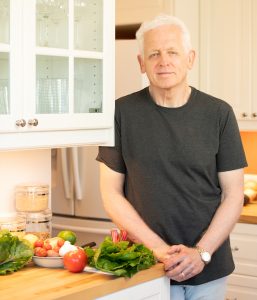How Did I Arrive Here?
I was born and raised in Montana in a lower middle-class household. The words “disposable income” didn’t exist back then so we had to pay attention if we were going to pay for the basics. I learned to cook at the insistence of my working mom who needed help getting evening meals on the table. I was barely a teenager, the youngest of 4 kids, and the only person in my family of six with no job at the moment, so I was drafted into kitchen duty.
Mom was a knowledgeable “meat and potatoes-style” cook so that’s where I started. She cooked a fair amount of fried foods, we had bacon every weekend and we kept a coffee can full of bacon fat on hand for cooking.
My mother was a creature of habit and had a fairly broad repertory of meal plans. She possessed an almost superhuman sense of smell. She cooked from memory and only used a recipe if she was baking. Her meals were delicious and my friends were never disappointed when they magically showed up at dinnertime and were invited to join us at the table. Things seldom spoiled in her fridge and little was wasted in her kitchen and she canned or froze copious amounts of fruits and vegetables during harvest season. In a time before computers, mom maintained a flawless mental inventory of her personal canning as well as her well stocked pantry of store-bought canned goods and condiments.
Dad was the breakfast specialist. He took over the morning cooking on weekends. Yes, he was the one who kept that can of bacon grease topped off. He was also the one who’d try making something “exotic” like a shrimp cocktail or Roquefort dressing. (Hey! Those were exotic in 1960’s Montana!) Dad, my two older brothers and I also contributed fish and game during the various hunting and fishing seasons and he butchered and wrapped the cuts of elk and venison himself (something he’d learned in one of his many “make-do” jobs during the great depression). Our family also went in on a half a hog or steer with some other family each year. That meat was kept frozen in a rented cold storage locker. In his 50’s and 60’s dad became an outstanding organic gardener and contributed fabulous fruits and vegetables to their meal planning.
As a young adult in the early 70’s, I moved to Seattle to sing with Seattle Opera. One of the big personal payoffs of those years was the new friends and artists I met from across the U.S. and around the world and the whole new world of favorite foods they introduced me to. That, combined with Seattle’s plethora of restaurants featuring unlimited international specialties, treated me to a flavor festival of new foods that blew my socks off.
All this served as the groundwork to being the meal planner and family chef as I was raising a family. Then came a game changer. When I was 34, dad had a heart attack followed a few years later by a disabling stroke. I was suddenly aware of my hereditary need to adopt a healthier diet. I began experimenting with the comfort-food dishes of my youth and became very adept at re-engineering old favorite recipes to make them healthier.
When my daughter was a teenager she became a vegetarian. I felt a need to know more about vegetarianism so I started reading. I wanted to be able to discuss the benefits and drawbacks of a meatless lifestyle with her and, I must admit, I was preparing to argue for a meat-based diet. I learned that, on the whole, vegetarians tend to be healthier than meat eaters and vegetarians stayed healthy and vibrant longer as they aged. Well that wasn’t helpful!
The problem was that the more I read about the meat production industry, the more I realized my daughter was going to prevail in that discussion about a meat-based diet. What’s more, I would never be able go back to being a carnivore. Damn! I loved my meat!!
We called them “slaughterhouses” when I grew up. Today that title’s been sanitized to “meat processing plants.” It’s a really big industry and one of our country’s most dangerous places to work. Today 4 manufacturers produce 85% of the beef in the U.S. and their environmental toll is enormous! When you pass one on the road you can smell it for miles. The industry doesn’t take good care of their workers, and as for the animals… well we all know how that ends.
My wife and I became vegetarians in 1997. Our meals were delicious, interesting, colorful and satisfying. We were staying fit in the process as well. However, after about 5 years we found it difficult to maintain the vegetarian lifestyle. We’re social animals, and our friends were suddenly reluctant to ask us to dinner. We also love to travel and it was next to impossible to find vegetarian choices on restaurant menus.
Since then we’ve migrated to a more “flexitarian” lifestyle. We include some fish in our diet, but we still avoid eating barnyard meats. We also make it a point to experiment with the ever-growing variety of plant-based “meat” options. I’ve incorporated cooking techniques that make them even more adaptable to our version of old-fashioned comfort-food recipes. True, most plant-based meats are highly processed, but the fact that they’re made with fraction of our natural resources it takes to raise an equal amount of meat earns them a place at the table.
Today, we no longer keep that can of bacon grease on hand. We’ve vastly reduced our carbon footprint, we’re healthy and active and friends and loved ones enjoy the creative offerings from Don’s New Melting Pot kitchen.

